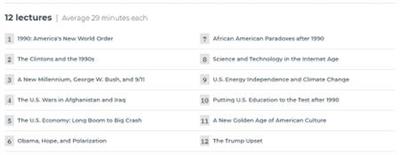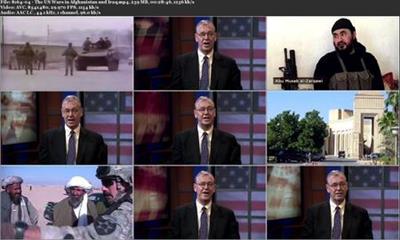TTC Video - America After the Cold War: The First Thirty Years
Course No. 8164 | .MP4, AVC, 1150 kbps, 854x480 | English, AAC, 96 kbps, 2 Ch | 12x29 mins | + PDF Guidebook | 3.08 GB
Lecturer: Patrick N. Allitt, Ph.D.
History is filled with surprises, not the least of which, was the fall of the Soviet Union in 1989.
But what about the 30 years following the fall of the Soviet Union? This period of history is still being written. The end of the Cold War is a natural stopping point, but also a natural starting point, an inflection point when one story ends and something new-something unpredictable from what happened before-begins. Nonetheless, events of today have also been profoundly shaped by the past several decades, and we must understand this recent history to understand today's world. Among other things, our world is a product of:
"New world order" that emerged in the 1990s, in which the United States was the sole remaining superpower on the world stage;
International conflicts, particularly driven by non-state actors and terrorists;
Political polarization that simmered during the Clinton administration and came to a rolling boil in the Obama and Trump administrations;
Golden age of science and technology that has profoundly reshaped our understanding of the universe and the way humans interact with each other; and
Business cycle extremes, with longer booms and a bigger bust, from the "great moderation" in the 1990s through the 2008 financial crisis and the years of slow recovery.
Contemporary life is changing so rapidly that it can be breathtaking to take a step back and look at the cohesive "story" from 1990 to 2019, but this is precisely what America after the Cold War: The First Thirty Years offers. Taught by esteemed professor and Great Courses favorite Dr. Patrick Allitt of Emory University, these 12 fascinating lectures tie the threads of contemporary life together to give you a rich understanding of the United States of America after the threat of annihilating war with the Soviet Union had miraculously passed.
After the fall of the Berlin Wall in 1989, it seemed the United States was poised for a new era of growth, equality, and peace. America after the Cold War: The First Thirty Years walks you through the promise, achievements, and shortcomings of America at the head of a self-proclaimed "new world order."
Explore America's Role on the World Stage
After the breakup of the Soviet Union, the United States was the sole remaining military superpower; yet, a look back to the 1990s shows a nation sometimes uneasy with this new role. When Saddam Hussein invaded Kuwait in 1990, American political leaders debated isolationism versus being the world's peacekeeper. President George H. W. Bush (the 41st president) chose a middle ground of sending in troops to defend Kuwait but stopping short of regime change in Iraq. And later in the decade, the United States chose not to get involved in conflicts in Bosnia and Rwanda.
Yet after the attack on American soil of 9/11 in 2001, President George W. Bush (the 43rd president) led America in a more active-and at times destructive-role in the world. After reviewing the events, alliances, and sociopolitical background at the time of the attack on September 11th, Professor Allitt walks you through the wars in Afghanistan and Iraq.
He takes an objective, historian's approach to recounting facts, and draws threads together to show how Presidents Obama and Trump either continued or rejected military intervention-and how Syria, for example, remains in tumult. In some ways, the story of America is the story of our leadership, for both good and ill.
Witness an Unprecedented Amount of Change
In parallel to America's military interventions abroad, our country was experiencing an astonishing amount of change on the domestic front. Professor Allitt takes you beyond the big headline events-O. J. Simpson, Clinton's impeachment trial, the 2000 election fiasco, the 2008 financial crisis, health care reform, the Mueller investigation-and shows you the significant trends that have shaped our society, such as:
Education: How does our public education system stack up against education systems throughout the world? What policies have we implemented and how have they worked? Consider the following programs: "No Child Left Behind," the "Race to the Top," charter schools, and more.
Science: From the Hubble Telescope to the human genome to emergent technologies, the past 30 years have seen a remarkable flourishing in STEM fields.
Technology: The smart phone, social media, navigation apps, disruptive online enterprises, and the emerging surveillance state have transformed how we interact with each other and the world.
Energy Independence: The controversial development of shale oil and natural gas has substantially freed the United States from reliance on energy imports from despotic and repressive regimes, while also making fossils fuels harder to resist.
Environment: From the Kyoto Protocol to the Fukushima disaster, and from "cap and trade" policy efforts to policies promoting solar and wind power, the relationship between industry, energy, and climate change is one of the most important themes in contemporary history.
Putting the Story of America Together
Perhaps the most profound change over the past 30 years is the massive amount of change within our American culture. For example, we have been experiencing an artistic golden age, with novelists, filmmakers, artists, architects, and musicians finding new ways to express the self and our time.
America has always been something of a paradox-a colony turned superpower, a productivity dynamo with a widening gulf between rich and poor, and a land of the free that has abetted inequality and racial injustice. One further paradox within our culture is the relationship between opportunity and oppression. Since 1990, the United States has seen an amazing leap in productivity and creativity, and most Americans are living the most enriched lives ever. The same country that elected the first black president to office also witnessed protest movements against police brutality and a resurgence of white nationalism. The context and connections you will uncover throughout the 12 lectures of this course can help you to better understand the paradoxes that lie at the heart of modern American history.
History remains full of surprising turns, as America after the Cold War: The First Thirty Years makes clear. The story of the United States is ongoing, but by synthesizing events and illuminating context with insight, Professor Allitt offers a fascinating exploration of the most recent roots of contemporary America.
Download link:Kod:rapidgator_net: https://rapidgator.net/file/3d09dd3861dac2438bacc14aa3206917/xlh7a.TTC.Video..America.After.the.Cold.War.The.First.Thirty.Years.part1.rar.html https://rapidgator.net/file/d6babe9f36eedfab1cbbbcdcfe6ca390/xlh7a.TTC.Video..America.After.the.Cold.War.The.First.Thirty.Years.part2.rar.html https://rapidgator.net/file/af9fec77f8828307305ef7efcb176cda/xlh7a.TTC.Video..America.After.the.Cold.War.The.First.Thirty.Years.part3.rar.html https://rapidgator.net/file/50cb51ad2578dd2c65e3c3848b9ebe7c/xlh7a.TTC.Video..America.After.the.Cold.War.The.First.Thirty.Years.part4.rar.html nitroflare_com: https://nitroflare.com/view/6BA3C05CEB65CB2/xlh7a.TTC.Video..America.After.the.Cold.War.The.First.Thirty.Years.part1.rar https://nitroflare.com/view/F8DDCF93BB9C90E/xlh7a.TTC.Video..America.After.the.Cold.War.The.First.Thirty.Years.part2.rar https://nitroflare.com/view/1FC8C91E4E98F35/xlh7a.TTC.Video..America.After.the.Cold.War.The.First.Thirty.Years.part3.rar https://nitroflare.com/view/912B2B8CDDDA231/xlh7a.TTC.Video..America.After.the.Cold.War.The.First.Thirty.Years.part4.rarLinks are Interchangeable - No Password - Single Extraction
1 sonuçtan 1 ile 1 arası
-
03.03.2020 #1Üye



- Üyelik tarihi
- 20.08.2016
- Mesajlar
- 144.947
- Konular
- 0
- Bölümü
- Bilgisayar
- Cinsiyet
- Kadın
- Tecrübe Puanı
- 153
TTC Video - America After the Cold War The First Thirty Years
Konu Bilgileri
Users Browsing this Thread
Şu an 1 kullanıcı var. (0 üye ve 1 konuk)



 LinkBack URL
LinkBack URL About LinkBacks
About LinkBacks







 Alıntı
Alıntı
Konuyu Favori Sayfanıza Ekleyin